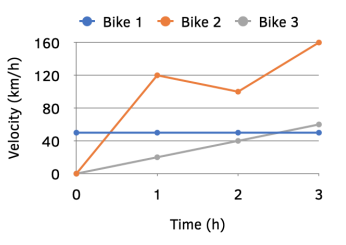Speed Calculation Examples (GCSE Physics)
Speed Calculation Examples
Practice Questions
Question: Sophia is driving down a long road. It takes her 3 minutes to travel 4.5km. Calculate the speed at which she is driving, giving your answer with units.
1. Get the correct units.
Before we start to tackle the question, we need to check that we are in the right units.
3 minutes = 180 seconds
4.5 km = 4500 metres
2. Rearrange the equation.
In order to use our equation, we must rearrange it to give speed as the subject.
s = vt
v = s/t
3. Put in the numbers.
Now we can substitute in the values that we are given in the question and give the speed in m/s.
v = 4500 / 180
v = 25 m/s
Question: Jack runs the London Marathon in 4 hours and 20 minutes. The Marathon is 41.4 km long. Calculate his speed in metres per minute. (4 hours 20 minutes is equivalent to 4.333 hours as 20 minutes is 1/3 of an hour).
Method 1: Converting units at the end
Speed = Distance / Time = 41.4 / 4.333 = 9.56 km / h
You need to multiply by 1000 to convert into metres = 9554 m / h
You need to divide by 60 to convert to minutes = 159 m / min
The answer is therefore C, 159m.
Method 2: Converting units at the start
Speed = Distance / Time = (41.4 x 1000) / (4.33 x 60) = 159 m / min
The answer is therefore C, 159m.
Question: The graph below shows the velocities of three different bikers on a 3 hour journey.

i) What was the difference between the distance covered by Bike 3 and Bike 1?
Speed = Distance / Time
Distance = Speed x Time = Area under graph
The average velocity for Bike 1 is 50 km/h.
The average velocity for Bike 3 can be calculated by doing (60 + 0) / 2 =
30 km/h. This only works because Bike 3 has a straight line – it is not
possible to do this for Bike 2.
Distance Bike 1 = 50 x 3 = 150 km
Distance Bike 3 = 30 x 3 = 90 km
The difference is 60km
ii) What is the distance covered by Bike 2?

Bike 2 does not have a straight line, so you have to work out the
distance under the line segment by segment.
Area of Triangle = base x height x 1/2
Area of Square = length x width
Triangle 1 = 1 x 120 x 0.5 = 60
Triangle 2 = 1 x 20 x 0.5 = 10
Triangle 3 = 1 x 60 x 0.5 = 30
Square 4 = 1 x 100 = 100
Square 5 = 1 x 100 = 100
Area under graph = 60 + 10 + 30 + 100 + 100 = 300km = C
iii) What is the average speed of Bike 2?
You can work out average speed by working out the gradient. However, the line is not straight, so instead you can calculate a gradient (= speed) for each hour, and then work out an average.
- For the first hour the bike travels at 60 km/h average: (120 + 0) / 2.
- For the second hour the bike travels at 110 km/h average: (120 + 100) / 2
- For the third hour the bike travels at 130 km/h average: (100 + 160) / 2
Average of journey = (60 + 110 + 130) / 3 = 100 km/h = D





Still got a question? Leave a comment
Leave a comment